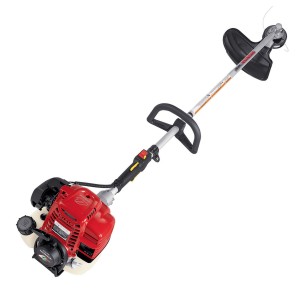 With models ranging from the compact VersAttach to professional models powered by their own unique four stroke engine, Honda’s brushcutters and string trimmers are able to deliver impressive performance for homeowners and landscape professionals. However, there’s more to using this equipment than just firing up the engine and pointing the head at some tall grass. These tips will help you use your trimmer safely and effectively.
With models ranging from the compact VersAttach to professional models powered by their own unique four stroke engine, Honda’s brushcutters and string trimmers are able to deliver impressive performance for homeowners and landscape professionals. However, there’s more to using this equipment than just firing up the engine and pointing the head at some tall grass. These tips will help you use your trimmer safely and effectively.
Safety
Unlike a mower, the head of a trimmer isn’t surrounded by a shroud, which means whatever is hit by the string or blade can be flung away at high speed, turning pebbles, plants and other objects into dangerous projectiles. When you use a trimmer, you should have full protection for your eyes, legs and feet, and you should always wear non-slip shoes or boots. People and animals should be kept away from where you’re working to keep them from being hit.
Ear protection is also a necessity due to the high level of noise generated by the cutting head and the engine. Even though Honda’s mini four strokes are far quieter than two-stroke engines, they can still cause hearing damage after prolonged use.
Always inspect the area for obstacles that could damage the trimmer or pose a safety hazard. Fence wire, chain, and electrical cables are particularly dangerous because they can wrap around the head. Once they tighten and jam the trimmer, it will kick back violently, causing serious injury.
Cutting Technique
The trimmer is designed to be used with the head parallel to the ground, floating just a couple inches from the surface. In some circumstances, the head may need to be used at an angle to get into crevices.
If you’re looking at the trimmer head from the top of the device, the head spins counter-clockwise. When trimming, the head should sweep right across the area being cut. This lets the string or blade slice into the plants and toss them against the debris shield, reducing the chance of turning these bits of growth or any objects hiding beneath them into projectiles. Once you’ve turned all the way to the right, swing back to the left before cutting again.
When cutting next to obstacles like walls and fences, tip the head slightly to the right. This will force ricocheting debris toward the ground.
Adjusting Harnesses and Handles
If you have a model that attaches to a shoulder harness, the proper adjustment will keep the trimmer in a comfortable position while maintaining the head position where you need it. The harness should be adjusted so that the quick release latch is resting on your hip. When the trimmer is attached, it should balance at an angle that places the head a few inched above the ground.
Whether or not your trimmer comes with a harness, the handle should be adjusted so that you can hold the trimmer in the correct position while your arms and shoulders are relaxed.
Getting More Line Out of the Head
To get more line out of a manual feed head, shut off the engine, then pull up on the head and twist it counter-clockwise.
Semi-matic and Pro-tap heads use a bump feed system. To get more line out, bump the head against the ground while the head is spinning. Always bump the head against soft ground: contact with pavement will grind off the surface of the head.
Using a Brushcutter Blade
String is great for cutting through young, green plants, but it will just slap the sides of woody plants. A brushcutter blade has the opposite problem: it goes through woody stems with ease, but it will just chew through young grass and weeds.
The basic technique for using a blade is the same as using the string head on your trimmer. However, it’s a good idea to check the area before cutting for unseen obstacles including rocks, branches, and other debris. While these will only wear down line, they can do serious damage to a blade.
On some models, Honda includes two debris shields. The shield with the cutoff knife should be used with trimmer line: this blade cuts off excess line as it passes by. The other shield is designed for use with the brushcutter blade. It’s shaped and supported to protect the operator from hardier grass.
When switching between the blade head and the line head, remember that everything on the shaft is reverse threaded so it won’t loosen during operation. Bolts and heads need to be turned left to tighten and right to loosen.
Keep Your Honda String Trimmer in Top Condition
Whether you need a brushcutter blade, a replacement harness or some engine parts, you can find everything you need for your Honda at www.hondalawnparts.com. We’re a certified dealer for Honda Small Engine equipment, and we can ship OEM parts to any address in the U.S. and Canada.
